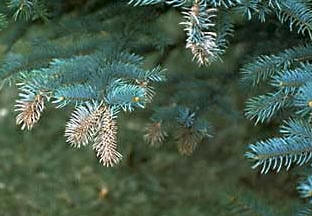Cooley Spruce Gall Adelgid
 DESCRIPTION
DESCRIPTION
In the northeastern United States, the most important hosts of the Cooley Spruce Gall Adelgid are Colorado Blue Spruce and Douglas-Fir, which are grown as landscape ornamentals and as Christmas trees. They also will attack Engelmann Spruce, Sitka and Oriental Spruce.
LIFE CYCLE
The Cooley Spruce Gall Adelgid has a complicated life cycle which involves five biological forms of the insect, three of which occur on Spruce and two on Douglas-Fir. It requires at least two years to complete all five forms on both hosts. The pest can thrive on Douglas-Fir alone by continuous reproduction of the two forms with as many as five to six generations produced each year. However, it appears that those forms occurring on Spruce can not continue producing indefinitely and need to find the second host, Douglas-Fir, to complete the entire life cycle. On Spruce, Cooley Spruce Gall Adelgids overwinter as immature females at the base of terminal buds. Females resume feeding in the Spring, mature and lay several hundred eggs on the lateral terminals. Eggs hatch in 10-14 days into young nymphs which migrate to new growth and feed at the base of the needles. Their feeding causes a gall which soon surrounds them. The insects remain in the chambers inside gall tissue throughout the Summer. By mid-Summer, the galls brown, dry out and the Adelgids emerge from the opened chambers. Then they migrate to Douglas-Fir or remain on Spruce. On Douglas-Fir, the migrating females lay eggs on the needle tips and one generation of Woolly Adelgids is produced. The following Spring adults mature and produce winged and wingless females. The winged females return to the Spruce to start the cycle over while the wingless females remain on the Douglas-Fir and reproduce indefinitely.
DAMAGE
On Spruce twigs, terminal galls are formed in response to feeding by the Adelgids and when infestations are heavy the resulting bud destruction destroys the shape of the tree. On Douglas-Fir, infested needles appear to be covered with snow. No galls are formed on Douglas-Fir, but feeding by the insects on the underside of the needle causes needle discoloration, needle distortion and premature needle drop.
CONTROL
Non-Chemical
Removing green colored galls during June or July before adult Adelgids emerge is practical for light infestations on a few trees. Be careful not to get any plant resin in your eyes.
Chemical
Formulations of several insecticides are registered for Spruce Gall Adelgid. Applications made in the fall are the most effective. Applications made in the spring are helpful. Do not spray Blue Spruce with horticultural spray oil – it takes ot the blue color.
* Select and apply horticultural spray oil before new growth starts and before buds separate into clusters. Make dormant season applications while temperatures remain above freezing. Horticultural spray oil removes glaucus (blue) color from evergreens such as Colorado Blue Spruce and Koster Spruce. To control overwintering Adelgids on Spruce, apply a registered insecticide from mid-September through October or just before buds break in April. Repeat applications may be necessary. Follow all label directions for specific information on host plant label clearance, phytotoxicity information, safety precautions and dosage information.
* See Woody Ornamental Insect, Mite and Disease Management, The Pennsylvania State University (2005) for more details.
WARNING: Pesticides are poisonous. Read and follow directions and safety precautions on labels. Handle carefully and store in original labeled containers out of reach of children, pets and livestock. Dispose of empty containers right away , in a safe manner and place. Do not contaminate forage, streams or ponds.
For professional assistance with tree and shrub problems contact a Keystone arborist
Penn State Fact Sheet on Spruce Gall


